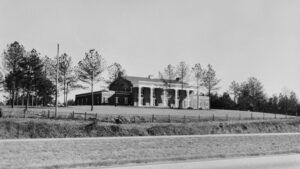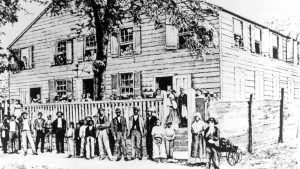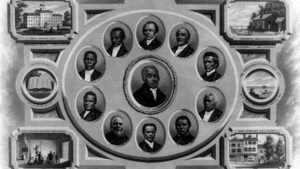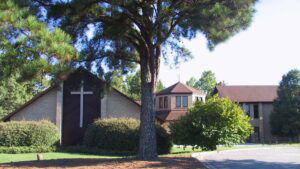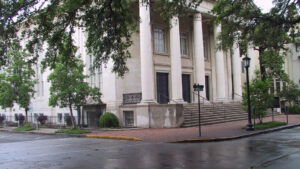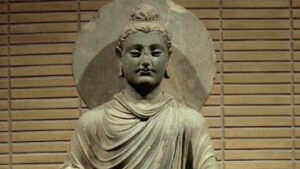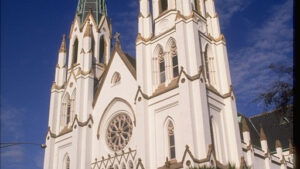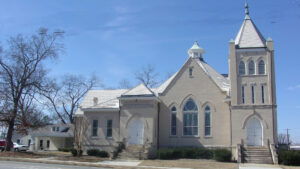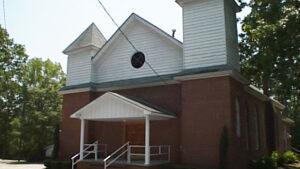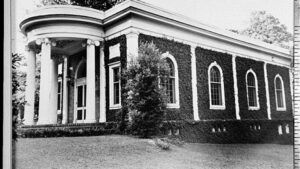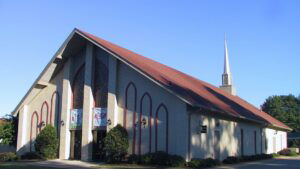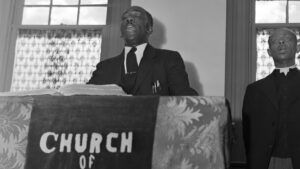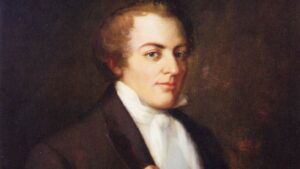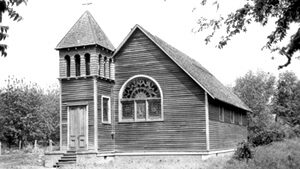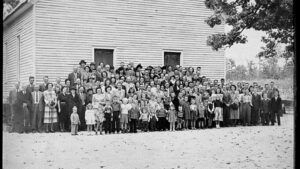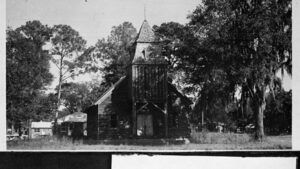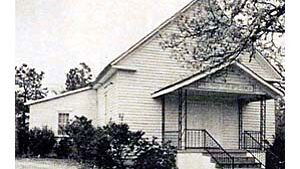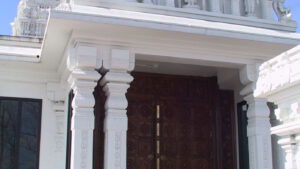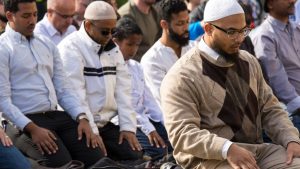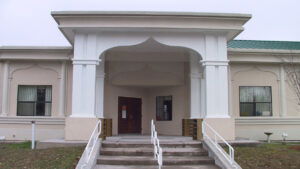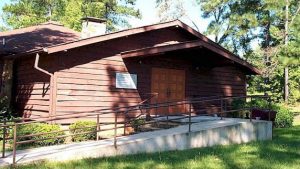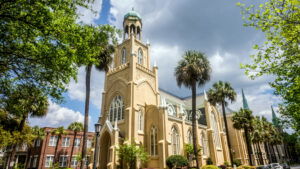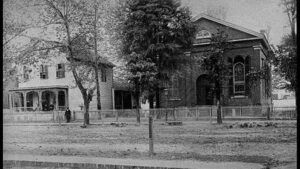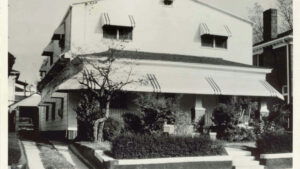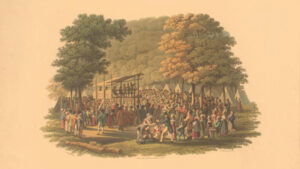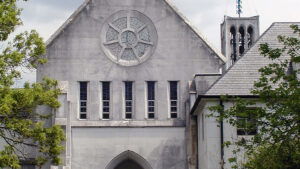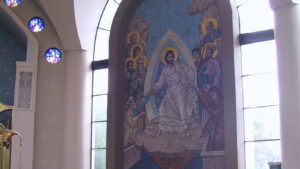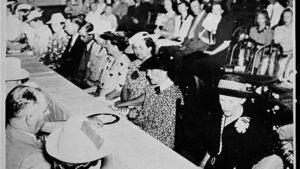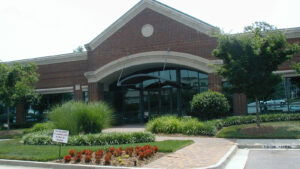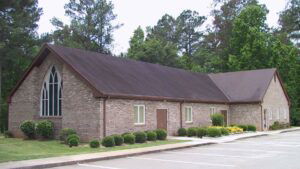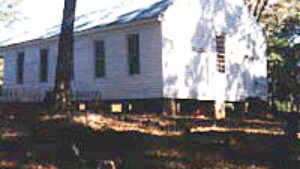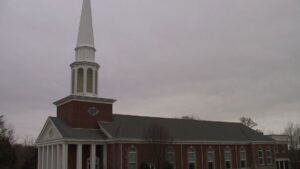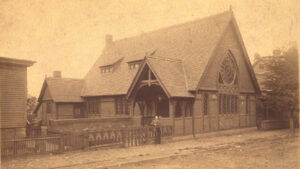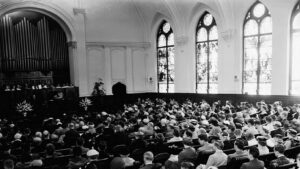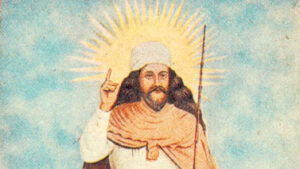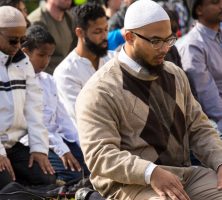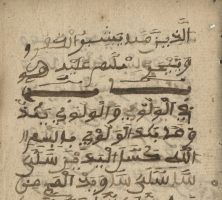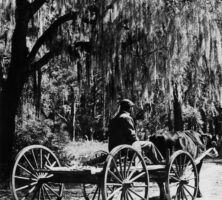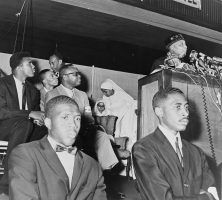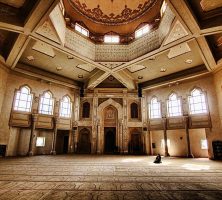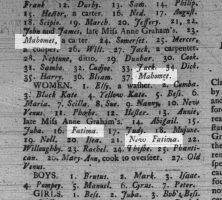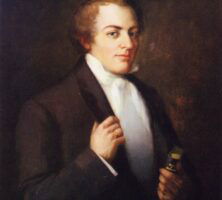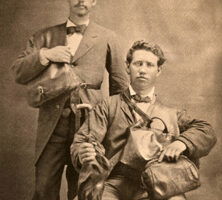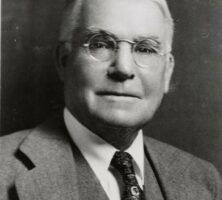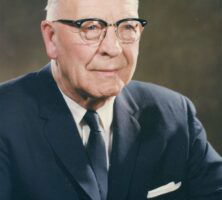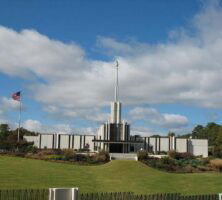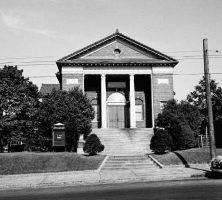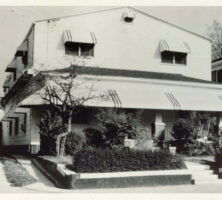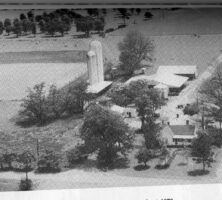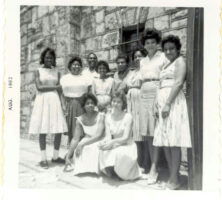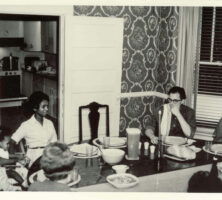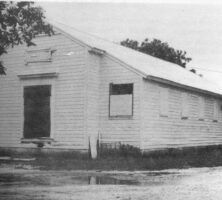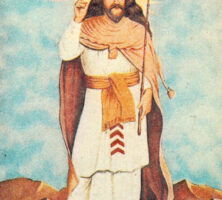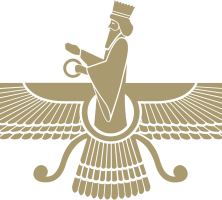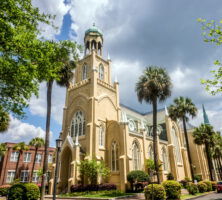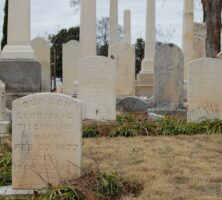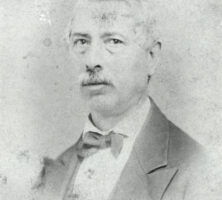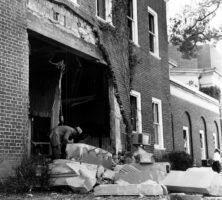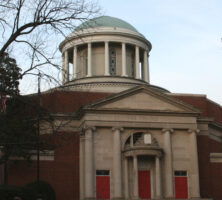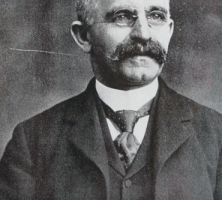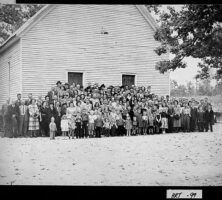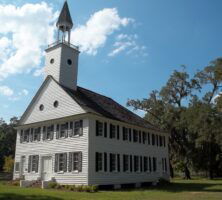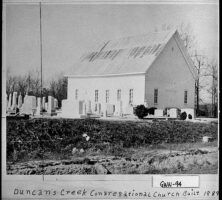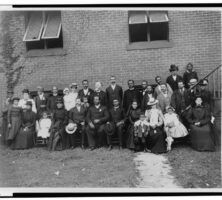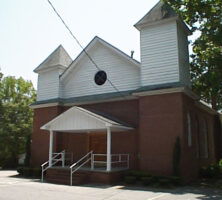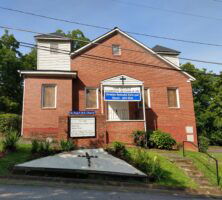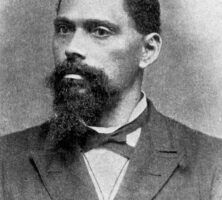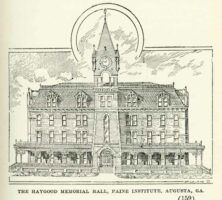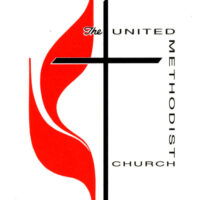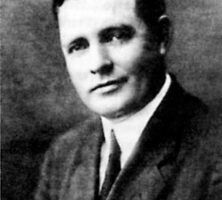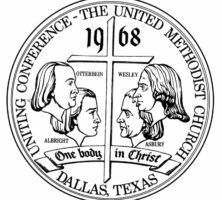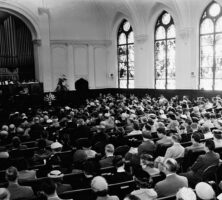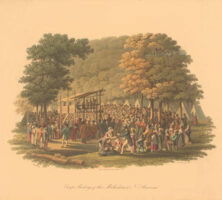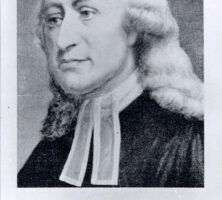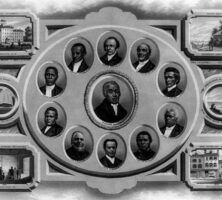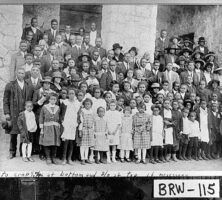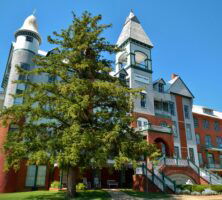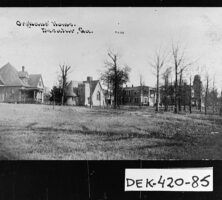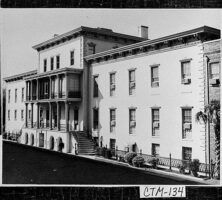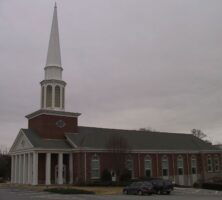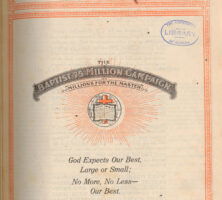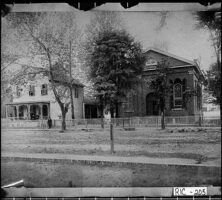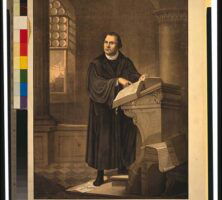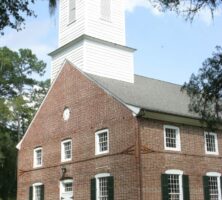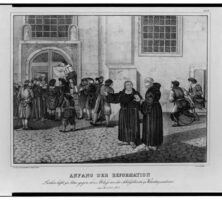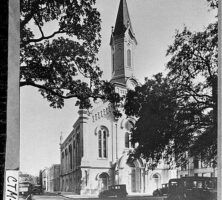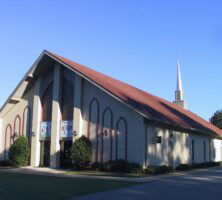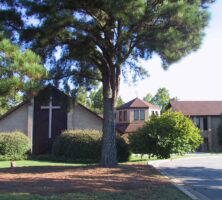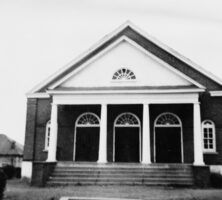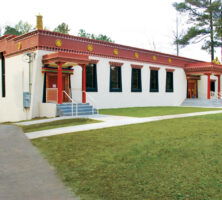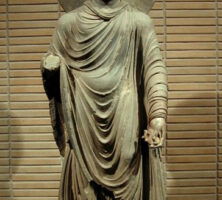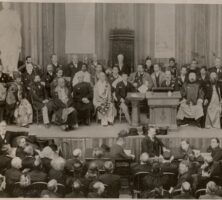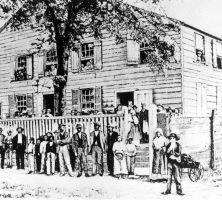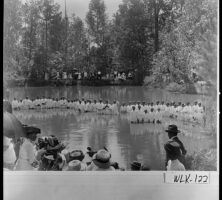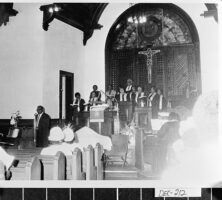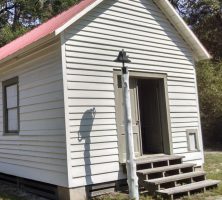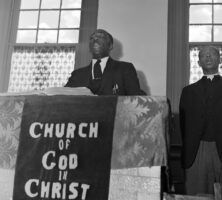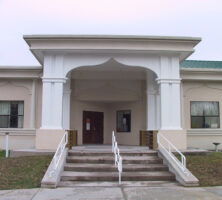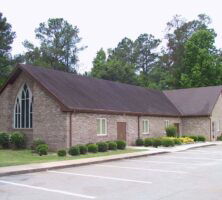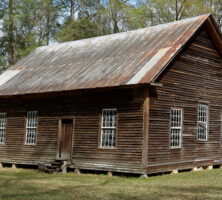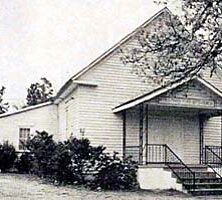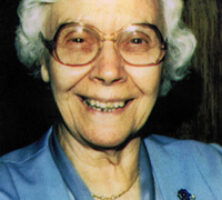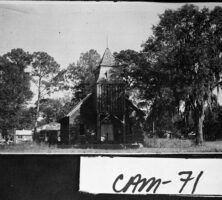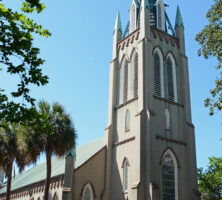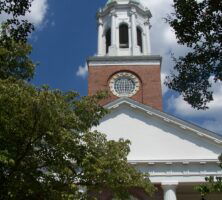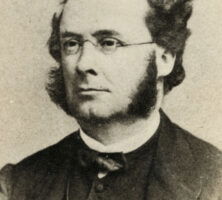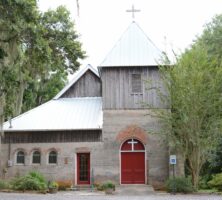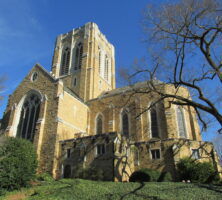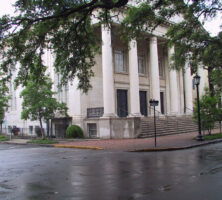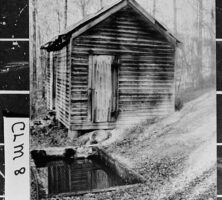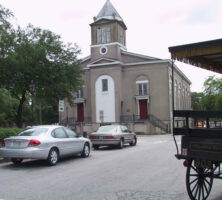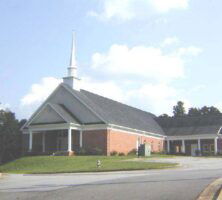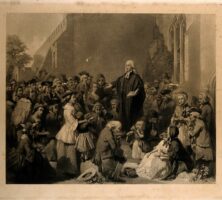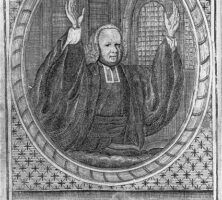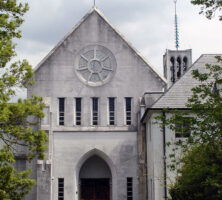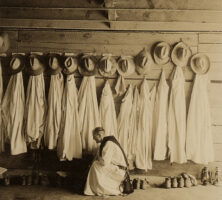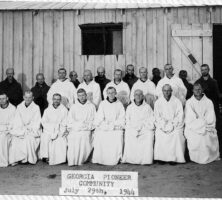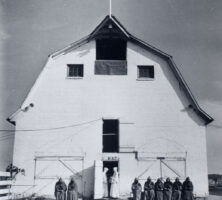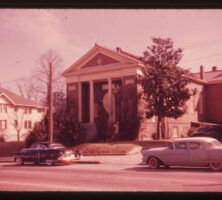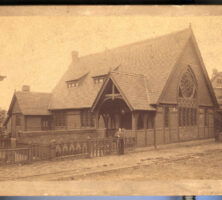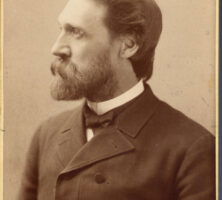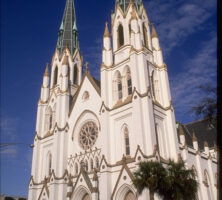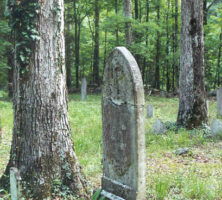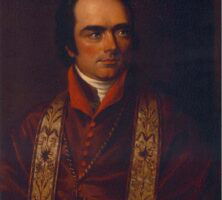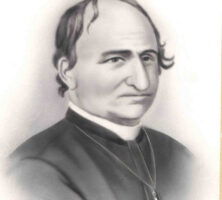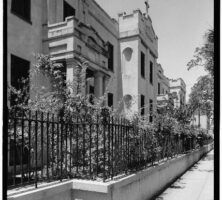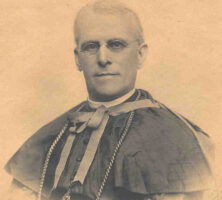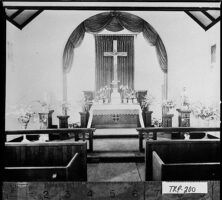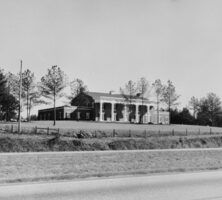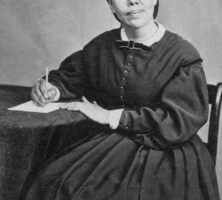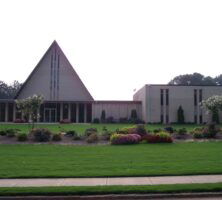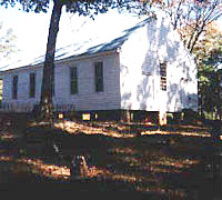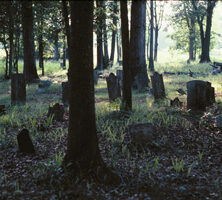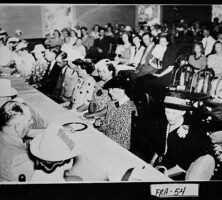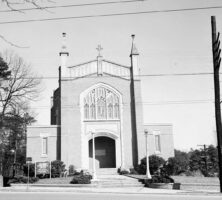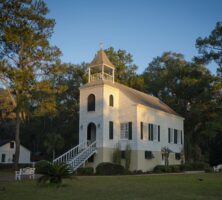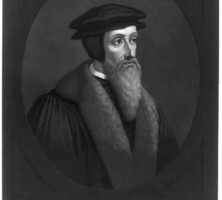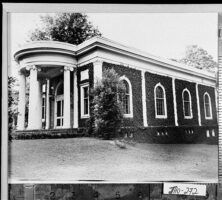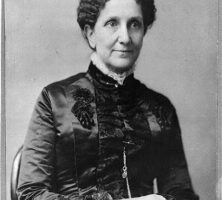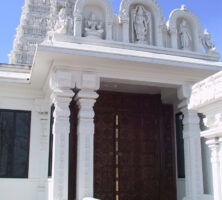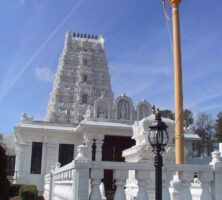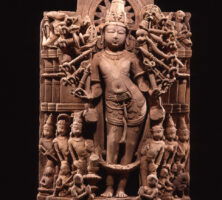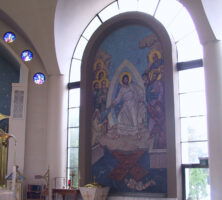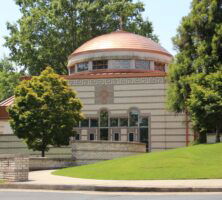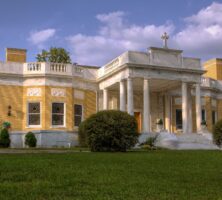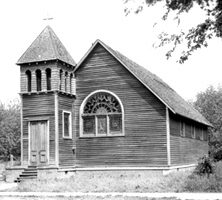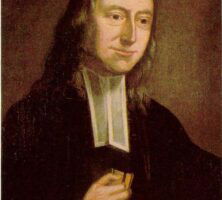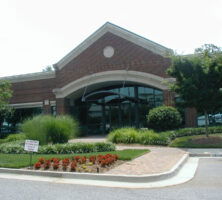The New Georgia Encyclopedia is supported by funding from A More Perfect Union, a special initiative of the National Endowment for the Humanities.
A group of Georgia Muslim protestors hold prayer at the Lutheran Church of the Redeemer in Midtown Atlanta. Members of multiple faiths gathered there in 2017 to protest immigration restrictions against majority-Muslim nations. Since the September 11th attacks in 2001, many Muslim communities have been subjected to government scrutiny and prejudicial acts.
Courtesy of Special Collections & Archives, Georgia State University Library, Atlanta Area Photographers Collection.
The New Georgia Encyclopedia does not hold the copyright for this media resource and can neither grant nor deny permission to republish or reproduce the image online or in print. Requests for permission to publish or reproduce the resource should be submitted to Special Collections and Archives at Georgia State University.
Bilali Mohammed, an enslaved African who lived openly as a Muslim on Sapelo Island, has been a subject of scholarly and popular interest since the nineteenth century. His experience is reflected in the “Bilali Document,” a brief manuscript he wrote concerning Islamic regulations.
Courtesy of Hargrett Rare Book and Manuscript Library, University of Georgia Libraries, Francis R. Goulding papers.
The New Georgia Encyclopedia does not hold the copyright for this media resource and can neither grant nor deny permission to republish or reproduce the image online or in print. Requests for permission to publish or reproduce the resource should be submitted to the Hargrett Manuscript and Rare Book Library at the University of Georgia.
This photograph, taken by Malcolm and Muriel Bell, captures Julius Bailey driving an ox cart along a Sapelo Island road around 1939. The image graces the cover of Drums and Shadows, a study of Black culture in coastal Georgia. Originally published in 1940, the book was reissued by the University of Georgia Press in 1986.
Courtesy of Georgia Historical Society, Muriel Barrow Bell and Malcolm Bell, Jr. collection, #GHS 1283-PH-03-02-101.
The New Georgia Encyclopedia does not hold the copyright for this media resource and can neither grant nor deny permission to republish or reproduce the image online or in print. All requests for permission to publish or reproduce the resource must be submitted to Georgia Historical Society.
A native of Sandersville who grew up in Cordele, Elijah Poole moved north in the Great Migration to escape the depredations of Jim Crow. While in Detroit, he heard a speech by the Nation's founder, Wallace Fard Muhammad, that proposed Islam as a tool for Black empowerment. Poole joined the movement, changed his name to Elijah Muhammad and, upon Fard’s death, assumed leadership of the Nation of Islam. Elijah Muhammad, pictured here at a podium, preached Black self-sufficiency and pride, arguing that Blacks were God’s original people while whites sprang from the devil.
Image from Wikimedia
The New Georgia Encyclopedia does not hold the copyright for this media resource and can neither grant nor deny permission to republish or reproduce the image online or in print. All requests for permission to publish or reproduce the resource must be submitted to the rights holder.
As Georgia became more prosperous in the 1970s, an increasing number of Muslim immigrants settled in the state, especially around Atlanta. These immigrants often retained their cultural and organizational distinctiveness by establishing ethnic-oriented masjids (the proper Arabic term for mosques) to worship apart from previously established masjids dominated by African Americans.
Photograph by Engineering Design Technologies
The New Georgia Encyclopedia does not hold the copyright for this media resource and can neither grant nor deny permission to republish or reproduce the image online or in print. All requests for permission to publish or reproduce the resource must be submitted to the rights holder.
Among the names of enslaved laborers on this Savannah-area planation in 1781 were four with names associated with Islam: Mahomet and Fatima. Mahomet is a Latin version of the name Muhammad, while Fatima was Muhammad’s daughter. Through Islamic names in lists like these and advertisements seeking fugitives from slavery, it is possible to discern the presence of enslaved Muslims in the early South.
From the Royal Georgia Gazette, March 8, 1781.
The New Georgia Encyclopedia does not hold the copyright for this media resource and can neither grant nor deny permission to republish or reproduce the image online or in print. All requests for permission to publish or reproduce the resource must be submitted to the rights holder.
Joseph Smith founded the Church of Jesus Christ of Latter-day Saints in 1830. Adherents of the church, known as Mormons, sent missionaries to Georgia first in the 1840s, and then again after the Civil War (1861-65).
Courtesy of the Church Archives, the Church of Jesus Christ of Latter-day Saints
The New Georgia Encyclopedia does not hold the copyright for this media resource and can neither grant nor deny permission to republish or reproduce the image online or in print. All requests for permission to publish or reproduce the resource must be submitted to the rights holder.
Mormon missionaries Rudger Clawson (left) and Joseph Standing are pictured in 1878. In 1879 Standing was killed by a mob in Whitfield County as he and Clawson were traveling to a church conference in Chattooga County.
Image from Church History Library
The New Georgia Encyclopedia does not hold the copyright for this media resource and can neither grant nor deny permission to republish or reproduce the image online or in print. All requests for permission to publish or reproduce the resource must be submitted to the rights holder.
Charles Callis directed the Southern States Mission of the Church of Jesus Christ of Latter-day Saints in Atlanta from 1919 to early 1934, when he left for Salt Lake City, Utah, to fulfull his 1933 calling to be one of the church's Quorum of Twelve Apostles.
Photograph by American Foto News. Courtesy of the Church Archives, the Church of Jesus Christ of Latter-day Saints
The New Georgia Encyclopedia does not hold the copyright for this media resource and can neither grant nor deny permission to republish or reproduce the image online or in print. All requests for permission to publish or reproduce the resource must be submitted to the rights holder.
LeGrand Richards succeeded Charles Callis in 1934 as the president of the Southern States Mission of the Church of Jesus Christ of Latter-day Saints in Atlanta.
Courtesy of the Church Archives, the Church of Jesus Christ of Latter-day Saints
The New Georgia Encyclopedia does not hold the copyright for this media resource and can neither grant nor deny permission to republish or reproduce the image online or in print. All requests for permission to publish or reproduce the resource must be submitted to the rights holder.
The Atlanta Georgia Temple, pictured circa 2009 and located in Sandy Springs, was the first Mormon temple erected in the South. Georgia governor George Busbee spoke at the building's groundbreaking in 1981, and the facility was dedicated two years later.
Photograph by Ray Luce
The New Georgia Encyclopedia does not hold the copyright for this media resource and can neither grant nor deny permission to republish or reproduce the image online or in print. All requests for permission to publish or reproduce the resource must be submitted to the rights holder.
A chapel of the Church of Jesus Christ of Latter-day Saints, pictured in 1952, was erected in Atlanta at the corner of Boulevard and North Avenue in 1925. The building served both as a meeting house and as the office for the Southern States Mission.
The New Georgia Encyclopedia does not hold the copyright for this media resource and can neither grant nor deny permission to republish or reproduce the image online or in print. Requests for permission to publish or reproduce the resource should be submitted to Special Collections and Archives at Georgia State University.
The Mennonite House, pictured in 1962, was located on Houston Street in Atlanta and served as a residence and headquarters for Mennonites active in the civil rights movement. The house was established by Vincent Harding, a Mennonite minister, and his wife, Rosemarie.
Reprinted by permission of Mennonite Church USA Historical Committee
The New Georgia Encyclopedia does not hold the copyright for this media resource and can neither grant nor deny permission to republish or reproduce the image online or in print. All requests for permission to publish or reproduce the resource must be submitted to the rights holder.
Menno L. Yoder's farm in Macon County, pictured circa 1970, is one of the farms comprising the Mennonite community in Montezuma. Mennonites maintain a rural, communal lifestyle, often choosing to limit the use of modern technology, dress, and entertainment.
Photograph from The Amish Mennonites of Macon County, Georgia, by E. S. Yoder
The New Georgia Encyclopedia does not hold the copyright for this media resource and can neither grant nor deny permission to republish or reproduce the image online or in print. All requests for permission to publish or reproduce the resource must be submitted to the rights holder.
An interracial Mennonite Bible school teaching team poses in Atlanta in 1963. These volunteers were part of a project sponsored in Atlanta by the Mennonite Central Commitee, which sent minister Vincent Harding to organize desegregation efforts in the South.
Reprinted by permission of Mennonite Church USA Historical Committee
The New Georgia Encyclopedia does not hold the copyright for this media resource and can neither grant nor deny permission to republish or reproduce the image online or in print. All requests for permission to publish or reproduce the resource must be submitted to the rights holder.
Residents of the Mennonite House, a center of civil rights activity in Atlanta from 1961 to 1964, gather around the "black and white table." The table, built in 1962 by Mennonites Vincent Harding and Bill Cooper, was made of light maple and dark mahogany or cherry, symbolizing racial unity.
Reprinted by permission of Mennonite Church USA Historical Committee
The New Georgia Encyclopedia does not hold the copyright for this media resource and can neither grant nor deny permission to republish or reproduce the image online or in print. All requests for permission to publish or reproduce the resource must be submitted to the rights holder.
The first meetinghouse used by the Mennonite community in Montezuma is pictured in 1981. The community was established in 1953 and today supports three schools and three churches.
Photograph from The Amish Mennonites of Macon County, Georgia, by E. S. Yoder
The New Georgia Encyclopedia does not hold the copyright for this media resource and can neither grant nor deny permission to republish or reproduce the image online or in print. All requests for permission to publish or reproduce the resource must be submitted to the rights holder.
The teachings of the prophet Zarathushtra, also known as Zoroaster, form the basis for the ancient monotheistic religion Zoroastrianism. Zarathushtra is thought by most scholars to have lived in what is now Iran sometime between 1500 and 1000 B.C. An active Zoroastrian community has existed in Atlanta since the early 1990s.
Courtesy of Alliance of Religions and Conservation
The New Georgia Encyclopedia does not hold the copyright for this media resource and can neither grant nor deny permission to republish or reproduce the image online or in print. All requests for permission to publish or reproduce the resource must be submitted to the rights holder.
The faravahar, a prominent motif in Middle Eastern art, functions as a symbol of the Zoroastrian faith. Interpretations of the symbol vary. Zoroastrianism is an ancient religion practiced around the world, with approximately 250 adherents in Georgia as of 2007.
Image from Wikimedia
The New Georgia Encyclopedia does not hold the copyright for this media resource and can neither grant nor deny permission to republish or reproduce the image online or in print. All requests for permission to publish or reproduce the resource must be submitted to the rights holder.
Congregation Mickve Israel in Savannah is the oldest Jewish congregation in the South and the third oldest in the United States. The congregation was founded during the establishment of the colony in 1733, and the current temple building was completed in 1878.
Photograph by Mark Kortum
The New Georgia Encyclopedia does not hold the copyright for this media resource and can neither grant nor deny permission to republish or reproduce the image online or in print. All requests for permission to publish or reproduce the resource must be submitted to the rights holder.
The New Georgia Encyclopedia does not hold the copyright for this media resource and can neither grant nor deny permission to republish or reproduce the image online or in print. All requests for permission to publish or reproduce the resource must be submitted to the rights holder.
The Jewish section of Oakland Cemetery in Atlanta is included in a database of cemeteries and burial sites compiled by the Jewish Cemetery Association of Georgia. The association was founded by volunteers at the William Breman Jewish Heritage Museum in Atlanta.
Photograph by Kate Wrightson
The New Georgia Encyclopedia does not hold the copyright for this media resource and can neither grant nor deny permission to republish or reproduce the image online or in print. All requests for permission to publish or reproduce the resource must be submitted to the rights holder.
During the antebellum period in Atlanta, most Jews supported the Confederacy, including David Mayer. Mayer served as Governor Joseph E. Brown's commissary officer, and later became a founding and longtime member of Atlanta's school board.
The New Georgia Encyclopedia does not hold the copyright for this media resource and can neither grant nor deny permission to republish or reproduce the image online or in print. All requests for permission to publish or reproduce the resource must be submitted to the William Breman Jewish Heritage Museum.
Detectives investigate the damage at the side entrance of the Hebrew Benevolent Congregation, commonly known as "the Temple," in Atlanta. The Temple was bombed on October 12, 1958, probably in response to the civil rights activism of the congregation's rabbi, Jacob Rothschild.
Courtesy of Atlanta Journal-Constitution.
The New Georgia Encyclopedia does not hold the copyright for this media resource and can neither grant nor deny permission to republish or reproduce the image online or in print. All requests for permission to publish or reproduce the resource must be submitted to the Atlanta Journal-Constitution.
The New Georgia Encyclopedia does not hold the copyright for this media resource and can neither grant nor deny permission to republish or reproduce the image online or in print. All requests for permission to publish or reproduce the resource must be submitted to the rights holder.
The Hebrew Benevolent Congregation, which first organized in 1860 as the Hebrew Benevolent Society, began construction in 1875 on a synagogue in Atlanta. The Temple, as it came to be known, continues to serve the Jewish community in the city.
Photograph by David
The New Georgia Encyclopedia does not hold the copyright for this media resource and can neither grant nor deny permission to republish or reproduce the image online or in print. All requests for permission to publish or reproduce the resource must be submitted to the rights holder.
The New Georgia Encyclopedia does not hold the copyright for this media resource and can neither grant nor deny permission to republish or reproduce the image online or in print. All requests for permission to publish or reproduce the resource must be submitted to the rights holder.
Herman Myers, a prominent member of the Jewish community in Savannah, was mayor of that city during the 1890s.
Photograph by Wikimedia
The New Georgia Encyclopedia does not hold the copyright for this media resource and can neither grant nor deny permission to republish or reproduce the image online or in print. All requests for permission to publish or reproduce the resource must be submitted to the rights holder.
The New Georgia Encyclopedia does not hold the copyright for this media resource and can neither grant nor deny permission to republish or reproduce the image online or in print. All requests for permission to publish or reproduce the resource must be submitted to the rights holder.
The New Georgia Encyclopedia does not hold the copyright for this media resource and can neither grant nor deny permission to republish or reproduce the image online or in print. All requests for permission to publish or reproduce the resource must be submitted to the rights holder.
Members of the Liberty Congregational Church in Hart County gather for a homecoming photograph, circa 1948. The church was likely established around 1878 by Moses Gordon Fleming and continues to be an active congregation.
Courtesy of Georgia Archives, Vanishing Georgia, #
hrt099.
The New Georgia Encyclopedia does not hold the copyright for this media resource and can neither grant nor deny permission to republish or reproduce the image online or in print. Requests for permission to publish or reproduce the resource should be submitted to the Georgia Archives.
The New Georgia Encyclopedia does not hold the copyright for this media resource and can neither grant nor deny permission to republish or reproduce the image online or in print. All requests for permission to publish or reproduce the resource must be submitted to the rights holder.
Midway Congregational Church, located in Liberty County, was founded in 1754 and is one of the oldest Congregational churches in the state. The current building was erected in 1792 to replace the church's first structure, which was burned in 1778 during the Revolutionary War.
Image from Ebyabe
The New Georgia Encyclopedia does not hold the copyright for this media resource and can neither grant nor deny permission to republish or reproduce the image online or in print. All requests for permission to publish or reproduce the resource must be submitted to the rights holder.
Duncan's Creek Congregational Church, pictured in 1955, was built in Gwinnett County in 1889. The Congregational denomination has maintained a presence in Georgia since the eighteenth century.
Courtesy of Georgia Archives, Vanishing Georgia, #
gwn094.
The New Georgia Encyclopedia does not hold the copyright for this media resource and can neither grant nor deny permission to republish or reproduce the image online or in print. Requests for permission to publish or reproduce the resource should be submitted to the Georgia Archives.
Members of the First Congregational Church, including the Reverend Henry Hugh Proctor (standing seventh from left), in Atlanta are pictured circa 1899. Today the church is an affiliate of the United Church of Christ, which formed in 1957.
Courtesy of Library of Congress, Prints and Photographs Division
The New Georgia Encyclopedia does not hold the copyright for this media resource and can neither grant nor deny permission to republish or reproduce the image online or in print. All requests for permission to publish or reproduce the resource must be submitted to the rights holder.
Mulberry Christian Methodist Episcopal Church was built in 1873 and offered church services and a school to Black residents of Lincolnton, the seat of Lincoln County. A congregation of approximately 200 members continues to meet in the church.
Courtesy of Lincolnton-Lincoln County Chamber of Commerce
The New Georgia Encyclopedia does not hold the copyright for this media resource and can neither grant nor deny permission to republish or reproduce the image online or in print. All requests for permission to publish or reproduce the resource must be submitted to the rights holder.
St. Paul Christian Methodist Episcopal Church, pictured in 2007, is located in Athens. The Christian Methodist Episcopal Church (CME Church) is a historically Black denomination established in 1870. Originally known as the Colored Methodist Episcopal Church, the denomination officially changed its name in 1956.
Photograph by Katie Korth
The New Georgia Encyclopedia does not hold the copyright for this media resource and can neither grant nor deny permission to republish or reproduce the image online or in print. All requests for permission to publish or reproduce the resource must be submitted to the rights holder.
As bishop of the Colored Methodist Episcopal Church, Lucius Holsey oversaw the growth of the denomination in his native state of Georgia. He was also instrumental in the establishment of Paine Institute (later Paine College), which opened in Augusta in 1884.
Photograph by Mathew B. Brady. Courtesy of National Archives and Records Administration
The New Georgia Encyclopedia does not hold the copyright for this media resource and can neither grant nor deny permission to republish or reproduce the image online or in print. All requests for permission to publish or reproduce the resource must be submitted to the rights holder.
Paine Institute (later Paine College) was founded in Augusta by leaders of the Colored Methodist Episcopal Church, including Lucius Holsey, in 1884. Haygood Memorial Hall (pictured) is known today as Haygood Holsey Hall and houses administrative offices.
Used with permission of Documenting the American South, the University of North Carolina at Chapel Hill Libraries
The New Georgia Encyclopedia does not hold the copyright for this media resource and can neither grant nor deny permission to republish or reproduce the image online or in print. All requests for permission to publish or reproduce the resource must be submitted to the rights holder.
The New Georgia Encyclopedia does not hold the copyright for this media resource and can neither grant nor deny permission to republish or reproduce the image online or in print. All requests for permission to publish or reproduce the resource must be submitted to the rights holder.
The Cross and Flame of the United Methodist Church represent the denomination's relationship to Christ and the Holy Spirit, respectively. The image also symbolizes founder John Wesley's epiphany during a Moravian meeting in 1738, when he felt his "heart strangely warmed."
Reprinted by permission of General Council on Finance and Administration of The United Methodist Church
The New Georgia Encyclopedia does not hold the copyright for this media resource and can neither grant nor deny permission to republish or reproduce the image online or in print. All requests for permission to publish or reproduce the resource must be submitted to the rights holder.
The New Georgia Encyclopedia does not hold the copyright for this media resource and can neither grant nor deny permission to republish or reproduce the image online or in print. All requests for permission to publish or reproduce the resource must be submitted to the rights holder.
The New Georgia Encyclopedia does not hold the copyright for this media resource and can neither grant nor deny permission to republish or reproduce the image online or in print. All requests for permission to publish or reproduce the resource must be submitted to the rights holder.
Arthur Moore was a prominent Methodist bishop in the Atlanta area from 1940 until his retirement in 1960. Before coming to Atlanta, Moore served as the pastor of churches in Texas and Alabama and, while bishop of the Pacific Coast area, led the Bishops' Crusade in 1937.
Courtesy of Moore Methodist Museum
The New Georgia Encyclopedia does not hold the copyright for this media resource and can neither grant nor deny permission to republish or reproduce the image online or in print. All requests for permission to publish or reproduce the resource must be submitted to the rights holder.
The 1968 Uniting Conference, held in Dallas, Texas, joined the Methodist Church and the Evangelical United Brethren, a Midwestern denomination, to form the United Methodist Church.
The New Georgia Encyclopedia does not hold the copyright for this media resource and can neither grant nor deny permission to republish or reproduce the image online or in print. All requests for permission to publish or reproduce the resource must be submitted to the rights holder.
The New Georgia Encyclopedia does not hold the copyright for this media resource and can neither grant nor deny permission to republish or reproduce the image online or in print. All requests for permission to publish or reproduce the resource must be submitted to the rights holder.
A congregation gathers in 1954 at Saint Mark United Methodist Church in Midtown Atlanta. The church was formed in 1872 as the Peachtree Street Mission (or the City Mission) of the First Methodist Church in Atlanta, and by 1875 was known as the Sixth Methodist Church. The congregation adopted its present name in 1902, the same year in which its current church building, designed by W. F. Denny, was constructed.
Courtesy of Special Collections & Archives, Georgia State University Library, Lane Brothers Commercial Photographers Photographic Collection.
The New Georgia Encyclopedia does not hold the copyright for this media resource and can neither grant nor deny permission to republish or reproduce the image online or in print. Requests for permission to publish or reproduce the resource should be submitted to Special Collections and Archives at Georgia State University.
The New Georgia Encyclopedia does not hold the copyright for this media resource and can neither grant nor deny permission to republish or reproduce the image online or in print. All requests for permission to publish or reproduce the resource must be submitted to the rights holder.
A hand-colored aquatint by M. Dubourg depicts a Methodist camp meeting held in North America, circa 1819. Camp meetings were a common event during the years of the Second Great Awakening, a series of Protestant revivals held between 1790 and 1830.
Courtesy of Library of Congress, Prints and Photographs Division
The New Georgia Encyclopedia does not hold the copyright for this media resource and can neither grant nor deny permission to republish or reproduce the image online or in print. All requests for permission to publish or reproduce the resource must be submitted to the rights holder.
John Wesley, a native of England, served as Anglican rector to the Georgia colony between 1735 and 1737. During this time, Wesley's interactions with Moravian settlers influenced his theological perspective, which eventually led to the formal establishment of the Methodist Church in England in 1784. His teachings also spread throughout the colonies, and the Methodist denomination in America was formalized that same year.
The New Georgia Encyclopedia does not hold the copyright for this media resource and can neither grant nor deny permission to republish or reproduce the image online or in print. For more information about this resource, contact the Stuart A. Rose Manuscript, Archives, and Rare Book Library at Emory University.
The New Georgia Encyclopedia does not hold the copyright for this media resource and can neither grant nor deny permission to republish or reproduce the image online or in print. All requests for permission to publish or reproduce the resource must be submitted to the rights holder.
The New Georgia Encyclopedia does not hold the copyright for this media resource and can neither grant nor deny permission to republish or reproduce the image online or in print. All requests for permission to publish or reproduce the resource must be submitted to the rights holder.
Richard Allen (center), the founder of the African Methodist Episcopal denomination, is depicted with other bishops in an 1876 lithograph. Established in Pennsylvania in 1816, the AME Church arrived in Georgia at the close of the Civil War, as missionaries from the denomination entered the state with Union troops.
Courtesy of Library of Congress, Prints and Photographs Division
The New Georgia Encyclopedia does not hold the copyright for this media resource and can neither grant nor deny permission to republish or reproduce the image online or in print. All requests for permission to publish or reproduce the resource must be submitted to the rights holder.
Members of the Bush Chapel African Methodist Episcopal Zion Church congregation in Barrow County pose at the church on Easter Sunday, 1925. The AME Zion denomination was founded in New York City in 1821 and arrived in the South to minister to freedpeople during the Civil War.
Courtesy of Georgia Archives, Vanishing Georgia, #
brw115.
The New Georgia Encyclopedia does not hold the copyright for this media resource and can neither grant nor deny permission to republish or reproduce the image online or in print. Requests for permission to publish or reproduce the resource should be submitted to the Georgia Archives.
Old Main Hall on the campus of Andrew College, a two-year institution in Cuthbert. Founded in 1854 as a women's college, today the school offers a liberal arts curriculum to approximately 400 male and female students. Named for Methodist bishop James Osgood Andrew, the school is affiliated with the United Methodist Church.
Image from Rivers Langley
The New Georgia Encyclopedia does not hold the copyright for this media resource and can neither grant nor deny permission to republish or reproduce the image online or in print. All requests for permission to publish or reproduce the resource must be submitted to the rights holder.
The Orphan's Home, pictured circa 1910, was founded in Norcross in 1871 but moved soon thereafter to its current location in Decatur. Known today as the United Methodist Children's Home, the institution houses around 70 children and provides a variety of social services to approximately 3,000 children each year.
Courtesy of Georgia Archives, Vanishing Georgia, #dek420-85.
The New Georgia Encyclopedia does not hold the copyright for this media resource and can neither grant nor deny permission to republish or reproduce the image online or in print. Requests for permission to publish or reproduce the resource should be submitted to the Georgia Archives.
Warren A. Candler Hospital, pictured in the early 1960s, was founded as a seaman's hospital in Savannah in 1803 and was acquired by the Methodist Episcopal Church, South, in 1930. The Methodists named the facility in honor of Bishop Warren A. Candler.
Courtesy of Georgia Archives, Vanishing Georgia, #
ctm134.
The New Georgia Encyclopedia does not hold the copyright for this media resource and can neither grant nor deny permission to republish or reproduce the image online or in print. Requests for permission to publish or reproduce the resource should be submitted to the Georgia Archives.
Mars Hill Baptist Church, located in Watkinsville, was founded in 1799. Pictured in 2006, the church is affiliated with the Southern Baptist Convention, which formed in Augusta in 1845.
Photograph by Kate Howard, New Georgia Encyclopedia
The New Georgia Encyclopedia does not hold the copyright for this media resource and can neither grant nor deny permission to republish or reproduce the image online or in print. All requests for permission to publish or reproduce the resource must be submitted to the rights holder.
The New Georgia Encyclopedia does not hold the copyright for this media resource and can neither grant nor deny permission to republish or reproduce the image online or in print. All requests for permission to publish or reproduce the resource must be submitted to the rights holder.
The New Georgia Encyclopedia does not hold the copyright for this media resource and can neither grant nor deny permission to republish or reproduce the image online or in print. All requests for permission to publish or reproduce the resource must be submitted to the rights holder.
The Christian Index, the official newspaper of the Georgia Baptist Convention, has a circulation of around 62,000. This issue, dated Thursday, April 7, 1921, is volume 101, number 14.
The New Georgia Encyclopedia does not hold the copyright for this media resource and can neither grant nor deny permission to republish or reproduce the image online or in print. All requests for permission to publish or reproduce the resource must be submitted to the rights holder.
Jehovah's Witnesses, an indigenous American religious group, hold services in buildings known as "kingdom halls." Pictured is the Kingdom Hall of Jehovah's Witnesses in Monticello.
Photograph by Benny Hawthorne
The New Georgia Encyclopedia does not hold the copyright for this media resource and can neither grant nor deny permission to republish or reproduce the image online or in print. All requests for permission to publish or reproduce the resource must be submitted to the rights holder.
Charles Taze Russell, pictured in 1917, founded the Watch Tower Bible and Tract Society, the forerunner of the modern-day Jehovah's Witnesses, in Pennsylvania in 1884. As of 2005 approximately 16,000 Witnesses made Georgia their home.
Courtesy of Library of Congress, Prints and Photographs Division, Historic American Buildings Survey, #HABS GA,107-SPLA,1-1.
The New Georgia Encyclopedia does not hold the copyright for this media resource and can neither grant nor deny permission to republish or reproduce the image online or in print. All requests for permission to publish or reproduce the resource must be submitted to the rights holder.
The German Lutheran Church in Augusta, pictured in 1895, was one of the many Lutheran churches to spring up around the state during the late nineteenth and early twentieth centuries.
Courtesy of Georgia Archives, Vanishing Georgia, #
ric205.
The New Georgia Encyclopedia does not hold the copyright for this media resource and can neither grant nor deny permission to republish or reproduce the image online or in print. Requests for permission to publish or reproduce the resource should be submitted to the Georgia Archives.
Martin Luther, depicted in an 1882 painting by F. W. Wehle, reads from the pulpit. A German monk, Luther began the Protestant movement in 1517 by rebelling against the authority of the Catholic Church. He was excommunicated by the Catholic Church in 1521 and went on to found "the churches of the Augsburg confession," the precursor to the Lutheran Church.
Courtesy of Library of Congress, Prints and Photographs Division
The New Georgia Encyclopedia does not hold the copyright for this media resource and can neither grant nor deny permission to republish or reproduce the image online or in print. All requests for permission to publish or reproduce the resource must be submitted to the rights holder.
Jerusalem Church was established by the Salzburgers in Ebenezer during the 1730s. Ebenezer, left in ruins after the Revolutionary War, had disappeared by 1855, but Jerusalem Church, now known as Jerusalem Evangelical Lutheran Church, still stands. It is one of the few buildings in Georgia left intact after the Revolutionary War.
Photograph by Bruce Tuten
The New Georgia Encyclopedia does not hold the copyright for this media resource and can neither grant nor deny permission to republish or reproduce the image online or in print. All requests for permission to publish or reproduce the resource must be submitted to the rights holder.
Legend holds that Martin Luther, the founder of Protestantism and the Lutheran Church, nailed ninety-five theses, or opinions, of dissent to the door of the Catholic church in Wittenberg, Germany, on October 31, 1517.
Courtesy of Library of Congress, Prints and Photographs Division
The New Georgia Encyclopedia does not hold the copyright for this media resource and can neither grant nor deny permission to republish or reproduce the image online or in print. All requests for permission to publish or reproduce the resource must be submitted to the rights holder.
Lutheran Church of the Ascension, pictured circa 1930, was built in Savannah during the 1870s in the Romanesque-Gothic style. Lutheran congregations struggled in the years after the Civil War to retain and attract members, but by the end of the nineteenth century, the denomination experienced a renewed growth in the state.
Courtesy of Georgia Archives, Vanishing Georgia, #ctm157.
The New Georgia Encyclopedia does not hold the copyright for this media resource and can neither grant nor deny permission to republish or reproduce the image online or in print. Requests for permission to publish or reproduce the resource should be submitted to the Georgia Archives.
The Cornerstone Church of God in Athens, pictured in 2006, is one of more than 500 Church of God congregations across the state. A Pentecostal denomination, the Church of God was founded in Tennessee in the late nineteeenth century and has maintained a presence in Georgia since 1903.
Photograph by Kate Howard, New Georgia Encyclopedia
The New Georgia Encyclopedia does not hold the copyright for this media resource and can neither grant nor deny permission to republish or reproduce the image online or in print. All requests for permission to publish or reproduce the resource must be submitted to the rights holder.
The Athens First Assembly of God, located in Athens, is one of more than 200 Assemblies of God congregations across the state. A Pentecostal denomination, the Assemblies of God formed in Arkansas in 1914 and began to grow in Georgia, primarily in rural areas, after 1945.
Photograph by Kate Howard, New Georgia Encyclopedia
The New Georgia Encyclopedia does not hold the copyright for this media resource and can neither grant nor deny permission to republish or reproduce the image online or in print. All requests for permission to publish or reproduce the resource must be submitted to the rights holder.
St. Paul AME Church in Macon is one of more than 500 African Methodist Episcopal churches in Georgia today. Pictured is the congregation's second structure, which was located on the site of the present-day Macon Coliseum. In 2006 the church moved into a new building on Shurling Drive.
Courtesy of Georgia Archives, Vanishing Georgia, # bib234.
The New Georgia Encyclopedia does not hold the copyright for this media resource and can neither grant nor deny permission to republish or reproduce the image online or in print. Requests for permission to publish or reproduce the resource should be submitted to the Georgia Archives.
The Drepung Loseling Monastery in Atlanta, the North American branch of Drepung Loseling Monastery in India, is a major Buddhist center in Georgia. Affiliated with Emory University, the center offers training in meditation and Tibetan Buddhist arts and sciences.
Courtesy of Drepung Loseling Monastery
The New Georgia Encyclopedia does not hold the copyright for this media resource and can neither grant nor deny permission to republish or reproduce the image online or in print. All requests for permission to publish or reproduce the resource must be submitted to the rights holder.
A statue, made around the second century A.D., depicts Siddhartha Gautama, also known as the Buddha. The teachings of Siddhartha in India around the fifth century B.C. form the foundation of modern Buddhism.
The New Georgia Encyclopedia does not hold the copyright for this media resource and can neither grant nor deny permission to republish or reproduce the image online or in print. All requests for permission to publish or reproduce the resource must be submitted to the rights holder.
The formal arrival of Buddhism in the West took place in 1893 at the World's Parliament of Religions, an interreligious forum held in Chicago, Illinois. Since that time the practice of Buddhism has become more widespread in the United States, and a number of temples and community centers have organized in Georgia.
Image from Wikimedia Commons
The New Georgia Encyclopedia does not hold the copyright for this media resource and can neither grant nor deny permission to republish or reproduce the image online or in print. All requests for permission to publish or reproduce the resource must be submitted to the rights holder.
The New Georgia Encyclopedia does not hold the copyright for this media resource and can neither grant nor deny permission to republish or reproduce the image online or in print. All requests for permission to publish or reproduce the resource must be submitted to the rights holder.
This post-Civil War sketch depicts members of Savannah's First Bryan Baptist Church, named after early Baptist minister Andrew Bryan, congregating outside the church building. The church is one of the oldest Black churches in North America.
Photograph by James M. Simms
The New Georgia Encyclopedia does not hold the copyright for this media resource and can neither grant nor deny permission to republish or reproduce the image online or in print. All requests for permission to publish or reproduce the resource must be submitted to the rights holder.
The New Georgia Encyclopedia does not hold the copyright for this media resource and can neither grant nor deny permission to republish or reproduce the image online or in print. All requests for permission to publish or reproduce the resource must be submitted to the rights holder.
The New Georgia Encyclopedia does not hold the copyright for this media resource and can neither grant nor deny permission to republish or reproduce the image online or in print. All requests for permission to publish or reproduce the resource must be submitted to the rights holder.
Forty-eight new adherents are baptized by the Reverend R. W. White in 1913 at New Salem Baptist Church in Wilkes County. The baptism ritual is a significant rite within the Baptist faith, symbolizing the individual's commitment of faith.
Courtesy of Georgia Archives, Vanishing Georgia, #
wlk122.
The New Georgia Encyclopedia does not hold the copyright for this media resource and can neither grant nor deny permission to republish or reproduce the image online or in print. Requests for permission to publish or reproduce the resource should be submitted to the Georgia Archives.
The choir of the First African Baptist Church in Bainbridge sings during a worship service in 1976. Music, beginning with the spirituals sung during the years of slavery, has long been an important aspect of the Black Baptist community.
Courtesy of Georgia Archives, Vanishing Georgia, #
dec212.
The New Georgia Encyclopedia does not hold the copyright for this media resource and can neither grant nor deny permission to republish or reproduce the image online or in print. Requests for permission to publish or reproduce the resource should be submitted to the Georgia Archives.
The First African Baptist Church, constructed in 1937, is on the northern end of Cumberland Island.
Photograph from National Park Service
The New Georgia Encyclopedia does not hold the copyright for this media resource and can neither grant nor deny permission to republish or reproduce the image online or in print. All requests for permission to publish or reproduce the resource must be submitted to the rights holder.
A minister preaches in 1942 at the Church of God in Christ in Washington, D.C. The largest Black Pentecostal denomination in the United States, the Church of God in Christ began in Mississippi during the 1890s and by the 1920s had founded twenty-one congregations in Georgia.
Courtesy of Library of Congress, Prints and Photographs Division
The New Georgia Encyclopedia does not hold the copyright for this media resource and can neither grant nor deny permission to republish or reproduce the image online or in print. All requests for permission to publish or reproduce the resource must be submitted to the rights holder.
The New Georgia Encyclopedia does not hold the copyright for this media resource and can neither grant nor deny permission to republish or reproduce the image online or in print. All requests for permission to publish or reproduce the resource must be submitted to the rights holder.
The New Georgia Encyclopedia does not hold the copyright for this media resource and can neither grant nor deny permission to republish or reproduce the image online or in print. All requests for permission to publish or reproduce the resource must be submitted to the rights holder.
The Jain Temple in Norcross, pictured in 2006, was built in the late 1990s by the Jain Society of Greater Atlanta, a group that practices the Indian religion Jainism. The temple was the first of its kind to be constructed in the state.
Photograph by Kate Howard, New Georgia Encyclopedia
The New Georgia Encyclopedia does not hold the copyright for this media resource and can neither grant nor deny permission to republish or reproduce the image online or in print. All requests for permission to publish or reproduce the resource must be submitted to the rights holder.
River Chapel Primitive Baptist Church in Columbus is one of the approximately 425 Primitive Baptist congregations, comprising around 13,500 members, that were established in Georgia as of 2005.
Photograph by Kate Howard, New Georgia Encyclopedia
The New Georgia Encyclopedia does not hold the copyright for this media resource and can neither grant nor deny permission to republish or reproduce the image online or in print. All requests for permission to publish or reproduce the resource must be submitted to the rights holder.
Bethlehem Primitive Baptist Church in Quitman was initially established in 1834 about a mile away from the site of the pictured building, which was constructed in the mid-1860s. Primitive Baptists formed as a separate denomination early in the nineteenth century.
Image from Jud McCranie
The New Georgia Encyclopedia does not hold the copyright for this media resource and can neither grant nor deny permission to republish or reproduce the image online or in print. All requests for permission to publish or reproduce the resource must be submitted to the rights holder.
The New Georgia Encyclopedia does not hold the copyright for this media resource and can neither grant nor deny permission to republish or reproduce the image online or in print. All requests for permission to publish or reproduce the resource must be submitted to the rights holder.
The Double Branch Free Will Baptist Church in Dooly County, pictured in 1972, was founded in 1896. The Free Will Baptist denomination, which emphasizes mission work and education, was established in Georgia in the 1830s by John Travis Brodnax and Cyrus White.
Courtesy of Geraldine Waid, Georgia Free Will Baptist Historical Society
The New Georgia Encyclopedia does not hold the copyright for this media resource and can neither grant nor deny permission to republish or reproduce the image online or in print. All requests for permission to publish or reproduce the resource must be submitted to the rights holder.
Laura Belle Barnard, a native of Glennville, was a Free Will Baptist missionary to India between 1935 and 1957. There she worked primarily with the "untouchables," the lowest class in the Hindu caste system. Also a prolific writer, Barnard was a professor at the Free Will Baptist College from 1960 until 1972.
Courtesy of Matt Pinson
The New Georgia Encyclopedia does not hold the copyright for this media resource and can neither grant nor deny permission to republish or reproduce the image online or in print. All requests for permission to publish or reproduce the resource must be submitted to the rights holder.
The New Georgia Encyclopedia does not hold the copyright for this media resource and can neither grant nor deny permission to republish or reproduce the image online or in print. All requests for permission to publish or reproduce the resource must be submitted to the rights holder.
An Episcopal church in St. Marys, identified as the Episcopal Colored Church, is pictured in 1954. During the 1950s and 1960s, Episcopalians in Georgia struggled with issues of segregation, along with the rest of the nation.
Courtesy of Georgia Archives, Vanishing Georgia, #
cam071.
The New Georgia Encyclopedia does not hold the copyright for this media resource and can neither grant nor deny permission to republish or reproduce the image online or in print. Requests for permission to publish or reproduce the resource should be submitted to the Georgia Archives.
One of the first Gothic revival churches in the state was St. John's Episcopal in Savannah, designed in 1850 by New York architect Calvin Otis and supervised by architect Calvin Fay. St. John's has distinctive pointed arches, buttresses, and great hammerbeam trusses on its interior.
Image from Jud McCranie
The New Georgia Encyclopedia does not hold the copyright for this media resource and can neither grant nor deny permission to republish or reproduce the image online or in print. All requests for permission to publish or reproduce the resource must be submitted to the rights holder.
St. Paul's Church was established in Augusta in 1750. Along with Christ Church in Savannah and Christ Church on St. Simons Island, St. Paul's was part of the first Anglican (later Episcopalian) diocese in Georgia.
Image from J. Stephen Conn
The New Georgia Encyclopedia does not hold the copyright for this media resource and can neither grant nor deny permission to republish or reproduce the image online or in print. All requests for permission to publish or reproduce the resource must be submitted to the rights holder.
In 1841 Stephen Elliott Jr. was appointed the first Episcopal bishop in Georgia. During the Civil War, Elliott led the movement that formed the Episcopal Church in the Confederate States of America. He was later instrumental in reconciling Northern and Southern churches at the war's end in 1865.
Courtesy of Hargrett Rare Book and Manuscript Library, University of Georgia Libraries, Georgia Photo File.
The New Georgia Encyclopedia does not hold the copyright for this media resource and can neither grant nor deny permission to republish or reproduce the image online or in print. Requests for permission to publish or reproduce the resource should be submitted to the Hargrett Manuscript and Rare Book Library at the University of Georgia.
St. Cyprian's Episcopal Church in Darien was built in 1876 for the area's Black congregation by the Reverend James Wentworth Leigh, who also served as pastor for the white congregation of St. Andrew's Episcopal Church. The church was constructed of tabby and named for an African saint.
Photograph by Judson McCranie
The New Georgia Encyclopedia does not hold the copyright for this media resource and can neither grant nor deny permission to republish or reproduce the image online or in print. All requests for permission to publish or reproduce the resource must be submitted to the rights holder.
The Cathedral of St. Philip in Atlanta serves as the seat of the Diocese of Atlanta, which comprises approximately 100 Episcopal congregations in north Georgia. St. Philip's was founded in 1846, and construction of the cathedral, which was dedicated in 1962, began in 1947.
Image from John Phelan
The New Georgia Encyclopedia does not hold the copyright for this media resource and can neither grant nor deny permission to republish or reproduce the image online or in print. All requests for permission to publish or reproduce the resource must be submitted to the rights holder.
Christ Church of Savannah, the first Anglican church to be established in the Georgia colony, was founded by Henry Herbert in 1733. The current church building, the third to be constructed on the site since 1744, was completed in 1838.
Image from Roman Eugeniusz
The New Georgia Encyclopedia does not hold the copyright for this media resource and can neither grant nor deny permission to republish or reproduce the image online or in print. All requests for permission to publish or reproduce the resource must be submitted to the rights holder.
First Baptist Church in Savannah, constructed on Chippewa Square in 1833, is the oldest church building in the city. The congregation formed in 1800 under pastor Henry Holcombe.
Photograph by Sarah E. McKee, New Georgia Encyclopedia
The New Georgia Encyclopedia does not hold the copyright for this media resource and can neither grant nor deny permission to republish or reproduce the image online or in print. All requests for permission to publish or reproduce the resource must be submitted to the rights holder.
The dressing room for baptismal candidates stands beside the baptismal pool of the Kiokee Baptist Church in Columbia County. The church, founded in 1772, is the first continuing Baptist church to be established in the state.
Courtesy of Georgia Archives, Vanishing Georgia, #
clm008.
The New Georgia Encyclopedia does not hold the copyright for this media resource and can neither grant nor deny permission to republish or reproduce the image online or in print. Requests for permission to publish or reproduce the resource should be submitted to the Georgia Archives.
The New Georgia Encyclopedia does not hold the copyright for this media resource and can neither grant nor deny permission to republish or reproduce the image online or in print. All requests for permission to publish or reproduce the resource must be submitted to the rights holder.
First African Baptist Church in Savannah, founded around 1777, is one of the oldest Black congregations in the United States. The church's current building was constructed in 1859 and houses a museum containing the church archives and historical artifacts.
Photograph by Sarah E. McKee, New Georgia Encyclopedia
The New Georgia Encyclopedia does not hold the copyright for this media resource and can neither grant nor deny permission to republish or reproduce the image online or in print. All requests for permission to publish or reproduce the resource must be submitted to the rights holder.
The New Georgia Encyclopedia does not hold the copyright for this media resource and can neither grant nor deny permission to republish or reproduce the image online or in print. All requests for permission to publish or reproduce the resource must be submitted to the rights holder.
The New Georgia Encyclopedia does not hold the copyright for this media resource and can neither grant nor deny permission to republish or reproduce the image online or in print. All requests for permission to publish or reproduce the resource must be submitted to the rights holder.
Shallowford Free Will Baptist Church in Marietta offers a variety of ministries to its congregation and the community, including Bible study, counseling, choir, and missions. An emphasis on both mission work and education forms a central tenet of the Free Will denomination.
Courtesy of Sean C. Powell
The New Georgia Encyclopedia does not hold the copyright for this media resource and can neither grant nor deny permission to republish or reproduce the image online or in print. All requests for permission to publish or reproduce the resource must be submitted to the rights holder.
James Oglethorpe, along with a twenty-one-member Board of Trustees, founded the colony of Georgia in 1733 and directed its development for nearly a decade. Although the board appointed Anglican clergy to the new colony, Oglethorpe welcomed settlers of a variety of religious persuasions.
Courtesy of Oglethorpe University
The New Georgia Encyclopedia does not hold the copyright for this media resource and can neither grant nor deny permission to republish or reproduce the image online or in print. All requests for permission to publish or reproduce the resource must be submitted to the rights holder.
John Wesley, appointed an Anglican rector for the Georgia colony in 1735, served at Christ Church in Savannah. Influenced by his interactions with Moravians during his time in Georgia, Wesley founded Methodism after his return to England in 1737.
Photograph from Wellcome Trust, Wikimedia
The New Georgia Encyclopedia does not hold the copyright for this media resource and can neither grant nor deny permission to republish or reproduce the image online or in print. All requests for permission to publish or reproduce the resource must be submitted to the rights holder.
An engraving of Anglican minister George Whitefield, created in 1774, depicts him preaching at a church in New York. A popular figure of the eighteenth-century Great Awakening in America, Whitefield founded the Bethesda orphanage near Savannah in 1740.
Courtesy of Library of Congress, Prints and Photographs Division
The New Georgia Encyclopedia does not hold the copyright for this media resource and can neither grant nor deny permission to republish or reproduce the image online or in print. All requests for permission to publish or reproduce the resource must be submitted to the rights holder.
The church at the Monastery of the Holy Spirit, completed in 1960, was built by the community of monks in Conyers. The monastery was established in 1944 by Trappist monks who moved from a monastery in Gethsemani, Kentucky, to found a new community in Georgia.
Courtesy of Our Lady of the Holy Spirit Monastery
The New Georgia Encyclopedia does not hold the copyright for this media resource and can neither grant nor deny permission to republish or reproduce the image online or in print. All requests for permission to publish or reproduce the resource must be submitted to the rights holder.
The Trappist monks at the Monastery of the Holy Spirit in Conyers are members of the Order of the Cistercians of the Strict Observance, a sect of Cistercian monks that originated in France and follows the teachings of the seventeenth-century abbot Armand de Rance.
Courtesy of Our Lady of the Holy Spirit Monastery
The New Georgia Encyclopedia does not hold the copyright for this media resource and can neither grant nor deny permission to republish or reproduce the image online or in print. All requests for permission to publish or reproduce the resource must be submitted to the rights holder.
The founders of the Monastery of the Holy Spirit in Conyers, pictured in 1944, traveled to Georgia from Kentucky in that year to establish a new Trappist monastery, which became the first in the country to form as a "daughter" community to another monastery within the United States.
Courtesy of Our Lady of the Holy Spirit Monastery
The New Georgia Encyclopedia does not hold the copyright for this media resource and can neither grant nor deny permission to republish or reproduce the image online or in print. All requests for permission to publish or reproduce the resource must be submitted to the rights holder.
Trappist monks settled in this barn in Conyers and began work on a monastery in 1944. By the end of that year, they had completed a temporary housing structure, and in 1959 the community members moved into the Monastery of the Holy Spirit, where they reside today.
Courtesy of Our Lady of the Holy Spirit Monastery
The New Georgia Encyclopedia does not hold the copyright for this media resource and can neither grant nor deny permission to republish or reproduce the image online or in print. All requests for permission to publish or reproduce the resource must be submitted to the rights holder.
The United Liberal Church in Atlanta reopened as an integrated congregation in 1954, after being closed by the American Unitarian Association in 1951 for practicing racial segregation. Members of the new church became active in the civil rights movement.
Courtesy of Unitarian Universalist Congregation of Atlanta Records, Pitts Theology Library, Emory University
The New Georgia Encyclopedia does not hold the copyright for this media resource and can neither grant nor deny permission to republish or reproduce the image online or in print. All requests for permission to publish or reproduce the resource must be submitted to the rights holder.
Church of Our Father, the first Unitarian church in Atlanta, was established in 1883 by George Leonard Chaney. Today the Atlanta-Fulton County Public Library stands on the church's original property at North Forsyth and Church streets.
Courtesy of Unitarian Universalist Congregation of Atlanta Records, Pitts Theology Library, Emory University
The New Georgia Encyclopedia does not hold the copyright for this media resource and can neither grant nor deny permission to republish or reproduce the image online or in print. All requests for permission to publish or reproduce the resource must be submitted to the rights holder.
George Leonard Chaney established the first Unitarian church in Atlanta in 1883. Chaney worked to create educational opportunities for African Americans in the city by serving on the board of trustees for the Atlanta University Center and by opening the first free lending library for Blacks.
Courtesy of Unitarian Universalist Congregation of Atlanta Records, Pitts Theology Library, Emory University
The New Georgia Encyclopedia does not hold the copyright for this media resource and can neither grant nor deny permission to republish or reproduce the image online or in print. All requests for permission to publish or reproduce the resource must be submitted to the rights holder.
First Christian Church of Sandersville is a congregation within the Christian Church (Disciples of Christ) fellowship, a Protestant group with roots in the Restoration Movement of the early nineteenth century.
Courtesy of Christian Church (Disciples of Christ) in Georgia
The New Georgia Encyclopedia does not hold the copyright for this media resource and can neither grant nor deny permission to republish or reproduce the image online or in print. All requests for permission to publish or reproduce the resource must be submitted to the rights holder.
Emily Tubman of Augusta, an early adherent of what is known today as the Christian Church (Disciples of Christ), poses for a photograph in the 1880s. Tubman generously supported the work of the Christian Church in Georgia by contributing funds to build and repair meeting places.
Courtesy of Georgia Archives, Vanishing Georgia, # ric089.
The New Georgia Encyclopedia does not hold the copyright for this media resource and can neither grant nor deny permission to republish or reproduce the image online or in print. Requests for permission to publish or reproduce the resource should be submitted to the Georgia Archives.
The New Georgia Encyclopedia does not hold the copyright for this media resource and can neither grant nor deny permission to republish or reproduce the image online or in print. All requests for permission to publish or reproduce the resource must be submitted to the rights holder.
The New Georgia Encyclopedia does not hold the copyright for this media resource and can neither grant nor deny permission to republish or reproduce the image online or in print. All requests for permission to publish or reproduce the resource must be submitted to the rights holder.
The New Georgia Encyclopedia does not hold the copyright for this media resource and can neither grant nor deny permission to republish or reproduce the image online or in print. All requests for permission to publish or reproduce the resource must be submitted to the rights holder.
St. John the Baptist in Savannah, the oldest Catholic cathedral in Georgia, opened in 1876 after three years of construction. After burning in 1898, the cathedral was rebuilt with funds donated from both Catholics and non-Catholics around the state.
Courtesy of Georgia Department of Economic Development.
The New Georgia Encyclopedia does not hold the copyright for this media resource and can neither grant nor deny permission to republish or reproduce the image online or in print. Requests for permission to publish or reproduce the resource may need to be submitted to the Georgia Department of Economic Development.
The first Catholic community in Georgia was established at Locust Grove, near modern-day Sharon, in the early 1790s. All that remains of the settlement today is a cemetery in Taliaferro County.
Courtesy of Catholic Diocese of Savannah Archives
The New Georgia Encyclopedia does not hold the copyright for this media resource and can neither grant nor deny permission to republish or reproduce the image online or in print. All requests for permission to publish or reproduce the resource must be submitted to the rights holder.
From 1820 until 1842, John England served as bishop of the Diocese of Charleston, which was created to support Catholic communities in Georgia, North Carolina, and South Carolina. During his tenure he founded an order of nuns called the Sisters of Mercy, who arrived in Georgia during the 1940s.
Courtesy of Catholic Diocese of Charleston Archives
The New Georgia Encyclopedia does not hold the copyright for this media resource and can neither grant nor deny permission to republish or reproduce the image online or in print. All requests for permission to publish or reproduce the resource must be submitted to the rights holder.
Augustin Verot, known as the "Rebel Bishop" for his support of the Confederacy during the Civil War, became bishop of the Diocese of Savannah in 1861 and led the Catholic community through the turbulent years of war and Reconstruction.
Courtesy of Catholic Diocese of Savannah Archives
The New Georgia Encyclopedia does not hold the copyright for this media resource and can neither grant nor deny permission to republish or reproduce the image online or in print. All requests for permission to publish or reproduce the resource must be submitted to the rights holder.
St. Vincent's Academy in Savannah was founded in the 1840s by the Sisters of Mercy, an order of nuns established by John England during his time as bishop of the Diocese of Charleston. The academy continues to operate as an all-girls' Catholic school in Savannah.
Courtesy of Library of Congress, Prints and Photographs Division, Historic American Engineering Record Collection, #HABS GA,26-SAV,81-1.
The New Georgia Encyclopedia does not hold the copyright for this media resource and can neither grant nor deny permission to republish or reproduce the image online or in print. All requests for permission to publish or reproduce the resource must be submitted to the rights holder.
Benjamin Keiley, named the seventh bishop of the Diocese of Savannah in 1900, was admired by Georgians of all faiths for his service in the army of Confederate general Robert E. Lee during the Civil War. Keiley served as bishop of the diocese until 1922.
Courtesy of Catholic Diocese of Savannah Archives
The New Georgia Encyclopedia does not hold the copyright for this media resource and can neither grant nor deny permission to republish or reproduce the image online or in print. All requests for permission to publish or reproduce the resource must be submitted to the rights holder.
Flowers decorate the altar of a Catholic church in LaGrange around 1936. In recognition of the growing number of Catholics in the Atlanta area, the Diocese of Savannah was reorganized into the Diocese of Savannah-Atlanta in 1937.
Courtesy of Georgia Archives, Vanishing Georgia, #
trp200.
The New Georgia Encyclopedia does not hold the copyright for this media resource and can neither grant nor deny permission to republish or reproduce the image online or in print. Requests for permission to publish or reproduce the resource should be submitted to the Georgia Archives.
The headquarters of the Georgia-Cumberland Conference of the Seventh-Day Adventist Church, pictured in 1976, is located in Calhoun. The conference includes churches in Georgia, North Carolina, and Tennessee.
Courtesy of Georgia Archives, Vanishing Georgia, # gor068.
The New Georgia Encyclopedia does not hold the copyright for this media resource and can neither grant nor deny permission to republish or reproduce the image online or in print. Requests for permission to publish or reproduce the resource should be submitted to the Georgia Archives.
The writings of Ellen G. White, who was considered to have prophetic powers as the result of divine revelations, were an important influence in the development of the Seventh-Day Adventist Church during the mid-nineteenth century. In 1892 White published her best-selling book, Steps to Christ.
Courtesy of Ellen G. White Estate, Inc.
The New Georgia Encyclopedia does not hold the copyright for this media resource and can neither grant nor deny permission to republish or reproduce the image online or in print. All requests for permission to publish or reproduce the resource must be submitted to the rights holder.
The Belvedere Seventh-Day Adventist Church in Decatur was founded in 1888 and is today part of the Georgia-Cumberland Conference.
Photograph by Yale A. Douce
The New Georgia Encyclopedia does not hold the copyright for this media resource and can neither grant nor deny permission to republish or reproduce the image online or in print. All requests for permission to publish or reproduce the resource must be submitted to the rights holder.
A replica of the original Quaker meetinghouse stands in Wrightsborough, which was founded in 1768 as a Quaker community in present-day McDuffie County. Opposed to slavery and therefore unable to compete in Georgia's economy, the Quakers, or Religious Society of Friends, began to leave the area during the late eighteenth century.
Courtesy of Sarah Shaw
The New Georgia Encyclopedia does not hold the copyright for this media resource and can neither grant nor deny permission to republish or reproduce the image online or in print. All requests for permission to publish or reproduce the resource must be submitted to the rights holder.
The New Georgia Encyclopedia does not hold the copyright for this media resource and can neither grant nor deny permission to republish or reproduce the image online or in print. All requests for permission to publish or reproduce the resource must be submitted to the rights holder.
Little remains of the Quaker settlement of Wrightsborough, located in present-day McDuffie County.
Courtesy of Forrest Shropshire
The New Georgia Encyclopedia does not hold the copyright for this media resource and can neither grant nor deny permission to republish or reproduce the image online or in print. All requests for permission to publish or reproduce the resource must be submitted to the rights holder.
The New Georgia Encyclopedia does not hold the copyright for this media resource and can neither grant nor deny permission to republish or reproduce the image online or in print. All requests for permission to publish or reproduce the resource must be submitted to the rights holder.
Members of the Hebron Presbyterian Church in Banks County take communion during a service in the 1930s. Founded in 1796, Hebron is believed to be the oldest Presbyterian church in the county.
Courtesy of Georgia Archives, Vanishing Georgia, #
fra054.
The New Georgia Encyclopedia does not hold the copyright for this media resource and can neither grant nor deny permission to republish or reproduce the image online or in print. Requests for permission to publish or reproduce the resource should be submitted to the Georgia Archives.
Covenant Presbyterian Church in Atlanta, founded in 1874, is a member of the Presbyterian Church in the United States, which is the largest Presbyterian body in Georgia.
Courtesy of Special Collections & Archives, Georgia State University Library, Lane Brothers Commercial Photographers Photographic Collection, 1920-1976.
The New Georgia Encyclopedia does not hold the copyright for this media resource and can neither grant nor deny permission to republish or reproduce the image online or in print. Requests for permission to publish or reproduce the resource should be submitted to Special Collections and Archives at Georgia State University.
The New Georgia Encyclopedia does not hold the copyright for this media resource and can neither grant nor deny permission to republish or reproduce the image online or in print. All requests for permission to publish or reproduce the resource must be submitted to the rights holder.
The New Georgia Encyclopedia does not hold the copyright for this media resource and can neither grant nor deny permission to republish or reproduce the image online or in print. All requests for permission to publish or reproduce the resource must be submitted to the rights holder.
The First Presbyterian Church of St. Marys is the oldest Presbyterian church building in the state of Georgia. It is also the oldest building in Georgia that has been in continuous use as a church since its erection in 1808.
Courtesy of Explore Georgia.
The New Georgia Encyclopedia does not hold the copyright for this media resource and can neither grant nor deny permission to republish or reproduce the image online or in print. Requests for permission to publish or reproduce the resource may need to be submitted to Explore Georgia.
John Calvin, a sixteenth-century French theologian, founded the Calvinist movement, which emphasizes a doctrine of predestination. The Calvinist theological tradition is the basis of the present-day Presbyterian Church belief system.
Courtesy of Library of Congress, Prints and Photographs Division
The New Georgia Encyclopedia does not hold the copyright for this media resource and can neither grant nor deny permission to republish or reproduce the image online or in print. All requests for permission to publish or reproduce the resource must be submitted to the rights holder.
The First Church of Christ Scientist in Thomasville, pictured around 1940, was dedicated in 1918. The Christian Science movement, founded in Massachusetts during the 1860s by Mary Baker Eddy, first arrived in Georgia in 1886, when Julia S. Bartlett, a follower of Eddy's, delivered a lecture in Atlanta.
Courtesy of Georgia Archives, Vanishing Georgia, #
tho272.
The New Georgia Encyclopedia does not hold the copyright for this media resource and can neither grant nor deny permission to republish or reproduce the image online or in print. Requests for permission to publish or reproduce the resource should be submitted to the Georgia Archives.
Mary Baker Eddy founded the Christian Scientists Association in 1876, one year after publishing her book Science and Health with Key to the Scriptures. Eddy claimed that, through direct revelation, she had acquired an understanding of healing.
Courtesy of Library of Congress, Prints and Photographs Division
The New Georgia Encyclopedia does not hold the copyright for this media resource and can neither grant nor deny permission to republish or reproduce the image online or in print. All requests for permission to publish or reproduce the resource must be submitted to the rights holder.
The Hindu Temple of Atlanta serves the growing Hindu population of northeast Georgia. The temple serves as the focus of Hindu life, where practitioners gather for worship, education, and social activities.
Photograph by Kate Howard, New Georgia Encyclopedia
The New Georgia Encyclopedia does not hold the copyright for this media resource and can neither grant nor deny permission to republish or reproduce the image online or in print. All requests for permission to publish or reproduce the resource must be submitted to the rights holder.
The Hindu Temple of Atlanta, the oldest Hindu temple in Georgia, was completed in 1990. Located in Riverdale, the temple is modeled on an ancient temple in Tirumala-Tirupathi, South India.
Photograph by Kate Howard, New Georgia Encyclopedia
The New Georgia Encyclopedia does not hold the copyright for this media resource and can neither grant nor deny permission to republish or reproduce the image online or in print. All requests for permission to publish or reproduce the resource must be submitted to the rights holder.
The New Georgia Encyclopedia does not hold the copyright for this media resource and can neither grant nor deny permission to republish or reproduce the image online or in print. All requests for permission to publish or reproduce the resource must be submitted to the rights holder.
This eleventh-century sandstone sculpture from India depicts the Hindu god Vishnu in his cosmic form. Vishnu's eighteen arms hold a variety of weapons, including those of the two other gods in the Hindu trinity, Shiva and Brahma. The sculpture is part of the Ester R. Portnow Collection of Asian Art at the Michael C. Carlos Museum in Atlanta.
Gift of Nathan Rubin-Ida Ladd Family Foundation. Courtesy of Michael C. Carlos Foundation
The New Georgia Encyclopedia does not hold the copyright for this media resource and can neither grant nor deny permission to republish or reproduce the image online or in print. All requests for permission to publish or reproduce the resource must be submitted to the rights holder.
A Byzantine-style mosaic inside the Greek Orthodox Cathedral of the Annunciation in Atlanta depicts the resurrection of Christ. Surrounded by Old Testament prophets and kings, the risen Christ delivers Adam and Eve from Hell.
Photograph by Melinda G. Smith, New Georgia Encyclopedia
The New Georgia Encyclopedia does not hold the copyright for this media resource and can neither grant nor deny permission to republish or reproduce the image online or in print. All requests for permission to publish or reproduce the resource must be submitted to the rights holder.
The Greek Orthodox Cathedral of the Annunciation, located at 2500 Clairmont Road in northeast Atlanta, is an example of an Eastern Orthodox church in Georgia. The church building was dedicated in 1970 and includes an educational wing.
Photograph by Thomson200 / CC0
The New Georgia Encyclopedia does not hold the copyright for this media resource and can neither grant nor deny permission to republish or reproduce the image online or in print. All requests for permission to publish or reproduce the resource must be submitted to the rights holder.
St. John Chrysostom's Melkite Church was formerly the home of Coca-Cola magnate Asa Candler. The converted church houses an altar made from marble quarried from Pickens County and is located at 1428 Ponce de Leon Avenue in the Druid Hills section of Atlanta.
Photograph by Gerg1967
The New Georgia Encyclopedia does not hold the copyright for this media resource and can neither grant nor deny permission to republish or reproduce the image online or in print. All requests for permission to publish or reproduce the resource must be submitted to the rights holder.
The New Georgia Encyclopedia does not hold the copyright for this media resource and can neither grant nor deny permission to republish or reproduce the image online or in print. All requests for permission to publish or reproduce the resource must be submitted to the rights holder.
Like many early Nazarene churches in Georgia, the Barnesville Church of the Nazarene grew out of a revival meeting. It was organized by district superintendent P. P. Belew in 1935, with twelve charter members.
Courtesy of Stan Ingersol
The New Georgia Encyclopedia does not hold the copyright for this media resource and can neither grant nor deny permission to republish or reproduce the image online or in print. All requests for permission to publish or reproduce the resource must be submitted to the rights holder.
The New Georgia Encyclopedia does not hold the copyright for this media resource and can neither grant nor deny permission to republish or reproduce the image online or in print. All requests for permission to publish or reproduce the resource must be submitted to the rights holder.
The history of Nazarenes in Georgia dates back to an evangelical revival in eighteenth-century England led by John and Charles Wesley. John Wesley is recognized as the founder of Methodism in America.
Reprinted by Permission of Drew University Library, Methodist Collection.
The New Georgia Encyclopedia does not hold the copyright for this media resource and can neither grant nor deny permission to republish or reproduce the image online or in print. All requests for permission to publish or reproduce the resource must be submitted to the rights holder.
The New Georgia Encyclopedia does not hold the copyright for this media resource and can neither grant nor deny permission to republish or reproduce the image online or in print. All requests for permission to publish or reproduce the resource must be submitted to the rights holder.
The denominational headquarters for the Presbyterian Church in America, pictured in 2006, are located in Lawrenceville. The denomination moved to Lawrenceville in 1982 and purchased its current building in 2001.
Photograph by Melinda S. Mullikin, New Georgia Encyclopedia
The New Georgia Encyclopedia does not hold the copyright for this media resource and can neither grant nor deny permission to republish or reproduce the image online or in print. All requests for permission to publish or reproduce the resource must be submitted to the rights holder.
The New Georgia Encyclopedia does not hold the copyright for this media resource and can neither grant nor deny permission to republish or reproduce the image online or in print. All requests for permission to publish or reproduce the resource must be submitted to the rights holder.
